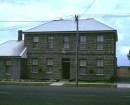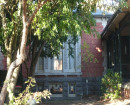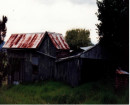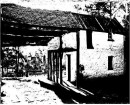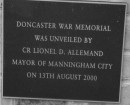Back to search results
AUSTRALIAN QUEER ARCHIVES (AQUA) COLLECTION
79-81 FITZROY STREET ST KILDA, PORT PHILLIP CITY
AUSTRALIAN QUEER ARCHIVES (AQUA) COLLECTION
79-81 FITZROY STREET ST KILDA, PORT PHILLIP CITY
All information on this page is maintained by Heritage Victoria.
Click below for their website and contact details.
Victorian Heritage Register
-
Add to tour
You must log in to do that.
-
Share
-
Shortlist place
You must log in to do that.
- Download report

8-80-08-Were-not-all-straight-in-the-garden-state-Doug-Lucas-and-Jan-Hillier-1981










On this page:
Statement of Significance
What is significant?
The Australian Queer Archives (AQuA) Collection, which consists of material related to Australia’s LGBTIQ+ people and communities, is of cultural heritage significance to the State of Victoria. The collection was formally established in 1978 and has grown, under several different names, since that time. It continues to grow and change and can be considered a 'living collection'. It comprises diverse material types, including ephemera, artworks, audiovisual material and objects.
How is it significant?
The AQuA Collection is of historical and social significance to the State of Victoria. It satisfies the following criterion for inclusion in the VHR:
Criterion A
Importance to the course, or pattern, of Victoria’s cultural history.
Importance to the course, or pattern, of Victoria’s cultural history.
Criterion B
Possession of uncommon, rare or endangered aspects of Victoria’s cultural history.
Possession of uncommon, rare or endangered aspects of Victoria’s cultural history.
Criterion G
Strong or special association with a particular present-day community or cultural group for social, cultural or spiritual reasons.
Strong or special association with a particular present-day community or cultural group for social, cultural or spiritual reasons.
Criterion H
Special association with the life or works of a person, or group of persons, of importance in Victoria’s history.
Why is it significant?
The AQuA Collection is historically significant as Victoria’s and Australia’s largest and most comprehensive collection of materials related to LGBTIQ+ people and communities. The substantial collection represents the diverse lives and experiences of LGBTIQ+ people, communities and sub-cultures and is unparalleled for its ability to enable these histories to be seen, studied and interpreted. Its establishment in 1978 was an outcome of the influential gay liberation movement of the 1970s and provides an ongoing link to this era. The collection has always been controlled by the communities it represents, and this is part of its history and significance. The collection has been housed in Victoria since its inception and Victorians have been key in its establishment, evolution and longevity.
(Criterion A)
The AQuA Collection is rare and uncommon for its ability to demonstrate Victoria’s LGBTIQ+ histories. The contents of AQuA Collection survive as rare tangible record of Victoria’s queer histories. The AQuA Collection items related to people's lives prior to the gay liberation era, when queer lives were criminalised, stigmatised and hidden, are particularly notable for their rarity.
(Criterion B)
The AQuA Collection is socially significant to Victoria’s and Australia’s LGBTIQ+ communities. As the only collection of its type in Australia, it has been an important touchstone of community identity since its establishment. The collection maintains a prominent profile in Victoria’s LGBTIQ+ communities and both the organisation and its collection are held in high esteem. It is controlled by the communities it represents, and this is an ongoing part of its social significance. It is publicly accessible and has evolved to become an invaluable resource for both academics and the queer community more broadly. AQuA is one of Victoria’s oldest continually operating LGBTIQ+ community organisations.
(Criterion G)
The AQuA Collection is significant for its association with the Australian Queer Archives – the organisation responsible for the establishment, survival and growth of the collection. As the primary organisation that has collected and conserved material related to LGBTIQ+ lives and experiences since 1978 it is an important organisation in Victoria’s history. Initially known as the Australian Gay Archives (AGA), and subsequently as the Australian Lesbian and Gay Archives (ALGA), it has been community-based, non-profit and volunteer-run since the archive’s establishment. The size, breadth and depth of the collection are a testament to the sustained efforts of the organisation over many decades.
(Criterion H)
Show more
Show less
-
-
AUSTRALIAN QUEER ARCHIVES (AQUA) COLLECTION - History
History
Gay Liberation Movement
In Australia during the mid-twentieth century, same-sex relationships and gender non-conforming practices were seldom discussed in the public sphere, and certainly not in positive terms. Homosexuality was ‘reviled and vilified’, and salacious reports in newspapers such as the Truth framed public understandings. Despite limited public discourse on homosexual relationships, acceptable sexual practices in public and private were strictly defined, under the law and in society more broadly. Both men and women faced serious consequences for being same-sex attracted or gender non-conforming. Homophobic intimidation, threats and violence were a reality on the streets and also ‘sanctioned by institutions’ such as the police and medical fraternity.
Despite this, from around the 1950s, there was also a gradual emergence of public spaces that catered to kamp men and women. In the 1960s, the portrayal of homosexuality as a threat to social fabric was interrogated and increasingly critiqued and began to enter more mainstream political discussions. Efforts to initiate law reform targeted at decriminalising (male) homosexuality came with the establishment of the Homosexual Law Reform Society in Canberra in 1969. The Campaign Against Moral Persecution (CAMP) had a branch in every Australian state the following year.
In the rapidly changing social climate of the 1970s, a highly political, organised, and active gay liberation movement emerged alongside other key social movements. A range of organisations on national and state levels targeted both law reform and broader social change. From the early 1970s, political and activist groups proliferated, focused on single issues or specific identities. As Steven Angelides has written, ‘the 1970s and 1980s were something of a watershed on the politics of gender and sexuality. Feminist and gay and lesbian movements had considerable success in challenging widespread social prejudice and discrimination.’ The Australian Gay Archives (AGA) emerged from this era of political activity.
Formation of the Australian Gay Archives (AGA) and first repositories in Melbourne
From the early 1970s, there was a growing awareness of the value of the records being created as part of Australia’s gay liberation movement. Several individuals began taking steps to preserve these records, often independently of each other. In Melbourne, teacher and gay activist Graham Carbery began collecting material related to gay activism, including flyers, periodicals and magazines.
The creation of an archive to document the emergence and development of the gay liberation movement was discussed at the second National Homosexual Conference in 1976. Also in 1976, Liz Ross and others founded the Gay Librarians Group in Melbourne which began to focus on compiling materials would be core to a collection on homosexuality. In early 1978, a gay archives group formed in Melbourne. In 1978, the proposal for an Australian Gay Archives (AGA) was formalised at the Fourth National Homosexual Conference. Carbery was key in the archive’s establishment, which also involved an Australia-wide network of individuals and organisations collecting and supplying material. From its inception, accessibility of the collection to the community has been key. As Sarah Rood has observed, ‘making the collection available to the lesbian and gay community as well as the broader community has been a critical element [of the collection] from its earliest day’. The archives were initially held at Carbery’s home in Flemington in inner Melbourne.
Growth and development of the Archives
From 1981, the archives were located in West Melbourne at The Hub – a premises hosted by Christ’s Community Church. From this point, the archives were open to the public at regular times – an arrangement that continues to this day. AGA was incorporated in 1983.
From 1989 until 1995 the collection was housed in the basement of Carbery’s home in Ivanhoe. In this period, the collection’s function as a valuable resource for researchers and academics increased. AGA formally changed its name to the Australian Lesbian and Gay Archives (ALGA) in 1991 to ‘better reflect the changes in the way the community described itself. The 1990s also saw increased public outreach by the archives via participating in community events like Midsumma and undertaking public programming. The collection grew beyond material relating to gay activism of the 1970s. Personal donations, bequests and a collection of oral histories enabled ALGA to represent the experiences of LGBTIQ+ people from periods when queer life was illegal and often covert.
The 1990s and 2000s saw the archives move once again, this time to the Victorian AIDS Council (VAC) in South Yarra to temporary office space occupied by VAC (later Thorne Harbour Health) on St Kilda Road, with additional material accommodated in offsite storage or at members’ homes.
AQuA today
In 2020, ALGA members voted to change the name of the archives to the Australian Queer Archives (AQuA) to reflect the diversity of queer communities beyond ‘gay and lesbian’. The term queer was felt to be ‘broadly inclusive’ of all the identities and communities represented within the collection. AQuA is now a key tenant within the Victorian Pride Centre on Fitzroy Street in St Kilda. The Pride Centre opened in 2021 and was a Victorian Government initiative to provide a purpose-built centre for Victoria’s LGBTIQ+ communities.
AQuA is the largest collection of its type in Australia and one of the oldest continuously operating organisations related to LGBTIQ+ communities. It continues to be dedicated to collecting, preserving and celebrating Australia’s queer histories. The collection is substantial and diverse. AQuA operates as a community-based, volunteer-run, not-for-profit organisation and is controlled and governed by members of the communities it represents.
The AQuA Collection and significance
A significance assessment undertaken by the Sarah Rood in 2010 found AQuA to be ‘the most significant collection relating to the history of homosexuality in Australia, as well as the development of the gay and lesbian community, communities and subcultures, in both Australia and the world.’ The 2021 publication A History of LGBTIQ+ Victoria in 100 Places and Objects recognised that ‘AQuA has cultural, historical and social importance as the largest and most complete collection of Australian LGBTIQ+ historical materials in the world.’
Social Value
As an organisation, AQuA is one of the oldest, continually operating LGBTIQ+ organisations in Victoria. Members of Victoria’s LGBTIQ+ communities hold the AQuA Collection and its custodians in high esteem. It is highly visible, accessible, and well-recognised as a valuable repository of community history and identity. The collection's holdings represent LGBTIQ+ communities from across Victoria and beyond, including regional and rural communities.
The attachment of Victoria’s LGBTIQ+ communities to the collection is evident in AQuA’s paid membership base, which numbers between roughly 350-450 annually, and its location within the new flagship Pride Centre. Members come from across Victoria as well as other states and territories. Membership is affordable and supports community engagement with the collection. Since 1978, volunteers have been drawn from within the LGBTIQ+ community, and donors (as well as prospective donors) also have an attachment to the organisation.
Accessibility of the collection to the communities it represents has been key since it was established and is an important part of communities’ attachment to the collection. The AQuA Collection is currently accessible to members, researchers and volunteers 2 days per week. The accessibility of the collection is supported by an array of guides, bibliographies and histories produced by AQuA.
The AQuA Collection is highly visible at key community events such as Midsumma, and its public profile is further supported by numerous public outreach activities such as exhibitions, conferences, talks, awards, and publications. A high-quality website and effective social media engagement also support community attachment to the collection.
The AQuA Collection’s growing and evolving nature underlines its social significance. Donations and bequests of documents and personal collections from community members demonstrate the collection’s importance. Having been formally established in 1978, there is a time depth to this attachment. The AQuA Collection’s longevity is a testament to the esteem in which it is held.
As the pre-eminent collection of its type in Australia, researchers and academics recognise and hold it in high esteem.
Selected bibliography
AQuA website .
Davison, Kate, Lesbian Bisexual Gay Transgender Material Survey, 2006.
Phillips, David L. and Graham Willett, Australia’s Homosexual Histories: Gay and Lesbian Perspectives 5, 2000.
Galligan, Brian and Winsome Roberts, Oxford Companion to Australian Politics, South Melbourne: Oxford University Press, 2007.
Robinson, Shirleene, Homophobia: an Australian history, Annandale: The Federation Press, 2008.
Rood, Sarah (Way Back When), The Australian Lesbian and Gay Archives: Assessment of Significance, 2010.
Willett, Graham, et al (AQuA), A History of LGBTIQ+ Victoria in 100 Places and Objects, 2021.
AUSTRALIAN QUEER ARCHIVES (AQUA) COLLECTION - Permit Exemptions
General Exemptions:General exemptions apply to all places and objects included in the Victorian Heritage Register (VHR). General exemptions have been designed to allow everyday activities, maintenance and changes to your property, which don’t harm its cultural heritage significance, to proceed without the need to obtain approvals under the Heritage Act 2017.Places of worship: In some circumstances, you can alter a place of worship to accommodate religious practices without a permit, but you must notify the Executive Director of Heritage Victoria before you start the works or activities at least 20 business days before the works or activities are to commence.Subdivision/consolidation: Permit exemptions exist for some subdivisions and consolidations. If the subdivision or consolidation is in accordance with a planning permit granted under Part 4 of the Planning and Environment Act 1987 and the application for the planning permit was referred to the Executive Director of Heritage Victoria as a determining referral authority, a permit is not required.Specific exemptions may also apply to your registered place or object. If applicable, these are listed below. Specific exemptions are tailored to the conservation and management needs of an individual registered place or object and set out works and activities that are exempt from the requirements of a permit. Specific exemptions prevail if they conflict with general exemptions. Find out more about heritage permit exemptions here.Specific Exemptions:Guidelines
1. Where there is an inconsistency between permit exemptions specific to the registered place or object (‘specific exemptions’) established in accordance with either section 49(3) or section 92(3) of the Act and general exemptions established in accordance with section 92(1) of the Act specific exemptions will prevail to the extent of any inconsistency.
2. In specific exemptions, words have the same meaning as in the Act, unless otherwise indicated. Where there is an inconsistency between specific exemptions and the Act, the Act will prevail to the extent of any inconsistency.
3. Nothing in specific exemptions obviates the responsibility of a proponent to obtain the consent of the owner of the registered place or object, or if the registered place or object is situated on Crown Land the land manager as defined in the Crown Land (Reserves) Act 1978, prior to undertaking works or activities in accordance with specific exemptions.
4. If a Cultural Heritage Management Plan in accordance with the Aboriginal Heritage Act 2006 is required for works covered by specific exemptions, specific exemptions will apply only if the Cultural Heritage Management Plan has been approved prior to works or activities commencing. Where there is an inconsistency between specific exemptions and a Cultural Heritage Management Plan for the relevant works and activities, Heritage Victoria must be contacted fora dvice on the appropriate approval pathway.
6. Specific exemptions do not constitute approvals, authorisations or exemptions under any other legislation, Local Government, State Government or Commonwealth Government requirements, including but not limited to the Planningand Environment Act 1987, the Aboriginal Heritage Act 2006, and the Environment Protection and Biodiversity Conservation Act 1999 (Cth). Nothing in this declaration exempts owners or their agents from the responsibility to obtain relevant planning, building or environmental approvals from the responsible authority where applicable.
7. Care should be taken when working with heritage buildings and objects, as historic fabric may contain dangerous and poisonous materials (for example lead paint and asbestos). Appropriate personal protective equipment should be worn at all times. If you are unsure, seek advice from a qualified heritage architect, heritage consultant or local Council heritage advisor.
8. The presence of unsafe materials (for example asbestos, lead paint etc) at a registered place or object does not automatically exempt remedial works or activities in accordance with this category. Approvals under Part 5 of the Heritage Act 2017 must be obtained to undertake works or activities that are not expressly exempted by the below specific exemptions.
9. All works should be informed by a Conservation Management Plan prepared for the place or object. The Executive Director is not bound by any Conservation Management Plan and permits still must be obtained for works suggested in any Conservation Management Plan.
Conditions
1. All works or activities permitted under specific exemptions must be planned and carried out in a manner which prevents harm to the registered place or object. Harm includes moving, removing or damaging any part of the registered place or object that contributes to its cultural heritage significance.
2. If during the carrying out of works or activities in accordance with specific exemptions original or previously hidden or inaccessible details of the registered place are revealed relating to its cultural heritage significance, including but not limited to historical archaeological remains, such as features, deposits or artefacts, then works must cease and Heritage Victoria notified as soon as possible.
3. If during the carrying out of works or activities in accordance with specific exemptions any Aboriginal cultural heritageis discovered or exposed at any time, all works must cease and the Secretary (as defined in the Aboriginal Heritage Act 2006) must be contacted immediately to ascertain requirements under the Aboriginal Heritage Act 2006.
4. If during the carrying out of works or activities in accordance with specific exemptions any munitions or other potentially explosive artefacts are discovered, Victoria Police is to be immediately alerted and the site is to be immediately cleared of all personnel.
5. If during the carrying out of works or activities in accordance with specific exemptions any suspected human remains are found the works or activities must cease. The remains must be left in place and protected from harm or damage. If there are reasonable grounds to believe that the remains are Aboriginal, the Victorian Aboriginal Heritage Council must be notified as soon as practicable, and, as required under s.17(3)(b) of the Aboriginal Heritage Act 2006, all details about the location and nature of the human remains must be provided to the Victorian Aboriginal Heritage Council (as defined in the Aboriginal Heritage Act 2006).
Exempt works and activities
1. Usual use and management of the collection (including, but not limited to, conservation activities, exhibition, loans and digitisation) in keeping with the practices, policies and procedures established by the AQuA Collection’s custodians.
2. Usual accessioning and deaccessioning of items in the collection in keeping with the practices, policies and procedures established by AQuA’s custodians, provided it does not result in the deaccessioning of more than 5% of the collection in a 12-month period.
3. Storage of collection items in locations other than the Pride Centre, and movement of items between locations, provided all locations are secure and do not cause or contribute to deterioration.AUSTRALIAN QUEER ARCHIVES (AQUA) COLLECTION - Permit Exemption Policy
1. The AQuA Collection is controlled by the communities it represents and this control is part of its cultural heritage significance. Inclusion in the VHR should support the community-led control of the collection. This is reflected in the proposed permit exemptions.
2. The permit exemptions are intended to support the ongoing day-to-day management of the collection. If a major change to the collection is proposed (such as complete relocation of the entire collection or deaccessioning of a significant percentage of the collection), or the collection is substantially damaged (for example, by flood or fire), contact should be made with Heritage Victoria.
-
-
-
-
-
LINDEN
 Victorian Heritage Register H0213
Victorian Heritage Register H0213 -
HALCYON
 Victorian Heritage Register H0775
Victorian Heritage Register H0775 -
THE MANSE
 Victorian Heritage Register H0212
Victorian Heritage Register H0212
-
194 Albion Street, Brunswick
 Merri-bek City
Merri-bek City -
194A Albion Street, Brunswick
 Merri-bek City
Merri-bek City
-
-





